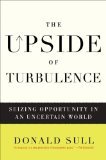Turbulence, IT and The New CIO
The New CIO is a weekly article about the challenges facing today’s CIO as well as what can be done to prepare for future challenges.
I just completed reading The Upside of Turbulence: Seizing Opportunity in an Uncertain World. Great book. Go buy it…the link above is an affiliate link or just go grab one from your favorite bookseller.
The book does an excellent job of discussing the world of business and the role that turbulence has played in shaping it. Donald Sull does a great job describing how to embrace turbulence and seize the opportunities that turbulence can bring.
How do you embrace turbulence? By being agile.
Before we continue, don’t confuse ‘being agile’ with the agile development methodology….while they may be similar, for the purposes of this article, I’ll be talking about a different ‘agile’.
That said, let me clear up what I mean when I saw agile (and what Donald Sull means when he uses it): Agile isn’t about speed. Agile has to do with the ability to change course when needed. Being agile means taking a look at your organizational landscape (strategy, operations, etc) and breaking up the long-term view into smaller samples of time to make it easier to see and respond to opportunities.
Dr Sull defines agility as:
“the capacity to identify and capture opportunities more quickly than rivals” (p. 138).
In addition, he uses the concept of air warfare to help tell the story of how agility can provide tremendous benefits. Out of these stories of air warfare, Dr Sull introduces John Boyd, a military strategist who helped with a lot of the science behind the F-16 and F-18 fighter jets, and Boyd’s OODA Loop.

What is the OODA loop? It stands for Observe, Orient, Decide, Act.
What does it have to do with IT? Everything.
In order to be an effective IT group and CIO in the world today, you’ve got to have some flexibility (i.e., be agile) so you can move quickly when opportunities arise.
As we all know, we are being asked to do more with less. The only way to do that, is to remain flexible (as well as have a good team and not overwork them). In addition to being agile, you’ve got to have a strategic plan and know how to execute that plan.
By using the OODA model, you might be able to be agile, plan and react as necessary. Let’s look at how you might incorporate the OODA model into your business life.
Observe
To use the OODA model, the first (and perhaps most important) step is to continuously observe.
Observe your situation. Look at your organization, team and the competitive landscape. What can you and your IT team do to help move the company forward?
In addition, observe how your team operates. Do you have enough people? Do you have the right people?
Is your strategic plan still valid based on these observations? What are the politics of your organization?
Orient
While observing, you’ll need to orient yourself to your landscape. Orientation (in the OODA model) is all about positioning yourself.
Is your organization changing direction? Are your competitors doing something differently that previously? Is your team becoming overloaded? Do you have the right people on board to make your plans successful?
Decide
You are observing your situation and have oriented yourself to the climate….now all you have to do is decide to do something. Can you make a decision? You better be able to.
In a turbulent world, you don’t have time to wait or over-analyze…you’ve got to decide quickly and move on. In the world of air warfare, if you wait you die and in today’s world your fate and your organization’s fate might just hang on your ability to decide.
Act
You’ve decided on a plan of action. Now you need to execute it. If you’ve observed, oriented and made the right decision, you can act with ease…but do you have the right people in place?
Many organizations plan well but very few ACT well. The ability to act and react after observing & orienting is a major reason that some organizations succeed and others don’t.
The New CIO & The Loop
The OODA model is built with feedback loops. Each action is fed back to the observation stage to review for tweaks. I’ve found that most organizations are missing this feedback mechanism…strategic plans are made and ‘rolled out’ without any feedback nor any way to change course quickly.
Dr Sull introduces his own version of the OODA loop…he calls it the ‘agility loop’. The agility loop has four stages:
- Make sense of situation
- Make choices
- Make it happen
- Make revisions
I like what Dr Sull has to say about the agility loop…whether you use the OODA loop or Sull’s Agility loop, you’ll be in a position to improve your agility.
To succeed in the future, The New CIO has to remain agile. Using the OODA loop (or Dr Sull’s agility loop) helps you keep your mindset right. Remember to observe, orient, decide & act. Then repeat.




Comments ()